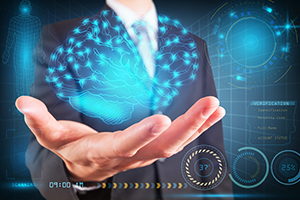Top Technology Trends for 2020
At the start of each year, the digital industry looks at which technologies, trends, and developments will be at the top of the agenda. From artificial intelligence to blockchain and the cloud to augmented reality, there is a focus on a large variety of technologiesŌĆöbut which will have a lasting influence, and which will disappear as the hype settles down?
Research by Gartner has revealed what are expected to be 2020ŌĆÖs biggest technology trends, with human augmentation and hyperautomation taking the top spots.
These are the five of the top technology trends in 2020 according to Gartner research and others. It is important that businesses pay attention to these so that they can remain competitive and ahead of their rivals.
1. Hyperautomation
Automation is where technology is used to automate tasks that would have once required a human. While automation is nothing newŌĆöproduction lines have been automating work processes for decadesŌĆöhyperautomation deals with the application of advanced technologies, such as AI and machine learning, to further automate processes and augment human workers.
As no single tool can replace humans entirely, hyperautomation today involves a combination of tools, including robotic process automation (RPA), intelligent business management software (iBPMS) and AI, with a goal of increasingly AI-driven decision making.
2. Human augmentation
Human augmentation involves the use of technology to enhance a personŌĆÖs cognitive and physical experiences.
Physical augmentation changes are an inherent capability that is achieved by implanting or hosting a technology physically within the body. For example, some industries use wearables to improve worker safety, and some medical devices can be implanted in the body for monitoring purposes.
In contrast, cognitive augmentation improves a humanŌĆÖs ability to think and make decisions. For example, exploiting information to enhance learning or gain new experiences. Cognitive augmentation includes technology in the brain, too, with physical implants that aid cognitive reasoning.
Of course, human augmentation has a range of implications for culture and ethics.
3. 5G will begin to mean something
While 5G is technically here, 2020 is the year when it will finally start to mean something. With the multiple global networks that can support and offer 5G
alongside a range of new 5G-ready devices, such as AppleŌĆÖs new iPhones for 2020, the benefits of it will start to truly be realized.
At the moment in time, there are very few devices that support the new standard, and fewer still that are acceptable to the early adopters and tech enthusiasts. Other devices that are expected to be 5G-ready will include the Pixel 5 and Samsung Galaxy S11.
4. Blockchain will become far more practical
Blockchain is a type of distributed ledger. It is an expanding list of cryptographically signed, irrevocable transaction records that are shared by all participants within a single network. Blockchain also allows parties to trace their assets all the way back to their origins, something that is beneficial for traditional assets and paves the way for a huge range of other uses. Blockchain also allows two or more strangers to safely interact and transact with one another in a digital environment, without the need for a centralized authority.
Today, enterprise blockchains take a practical approach and only implement some of the elements of a complete blockchain. Over time, starting from next year, blockchain will start to become a lot more practical and ŌĆśaccessibleŌĆÖ to other people and industries while benefitting the economy and other complementary technologies.
As these complementary technologies such as the IoT and AI begin to integrate alongside blockchain, the pool of participants is widened to include machines which will then be able to be used to exchange a variety of assets automatically and safely.
5. AI security
Evolving technologies such as the IoT, 5G, and hyperautomation, among other things, offer transformational opportunities in the commercial world. However, they also create a huge number of security vulnerabilities which are just waiting to be exploited by hackers.
Luckily, AI can also be used to bolster security and transform the entire security space. AI security has three key fundamentals:
1. ProtectingAI-poweredsystems;
2. LeveragingAItoenhancesecurityanddefense;and
3. AnticipatingtheuseofAIbyattackersandprotectingagainstit.
AI security is already being used by some of the worldŌĆÖs top organizations to protect their vital assets, among other things, from the threat of hackers and other security problems.
Interested in Learning More?
If you want to find out more about the technologies that are shaping our world and are set to come to fruition in 2020, contact SBM today. Our team of expert IT consultants are on-hand to provide you with simple guidance, straightforward advice, and practical solutions to modern technology-related problems.
┬Ā
┬Ā
















